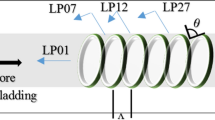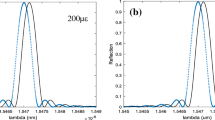Abstract
The main physical quantities in fiber Bragg grating are temperature and strain. The temperature sensors for different materials have been analyzed in this work. The sensing can be possible on the range of Bragg wavelength shifts occurred by the temperature change in the medium. Thus, the temperature is measurement based on the wavelength shifting of the fiber Bragg grating. The mathematical descriptions and simulation of various parameters of FBG temperature sensor are also included in the work.
The original version of this chapter was revised: Incorrect co-author name has been corrected. The erratum to this chapter is available at https://doi.org/10.1007/978-981-10-7395-3_77
Access provided by CONRICYT-eBooks. Download conference paper PDF
Similar content being viewed by others
Keywords
- Fiber Bragg grating (FBG)
- Reflectivity
- Temperature sensor
- Thermo-optic coefficient
- Thermal expansion coefficient
1 Introduction
Fiber Bragg gratings are periodic changes of the refractive index occurred in the core of an optical fiber and formed by UV laser light under particular condition. Many functions like reflection and filtering can be performed by this device in a highly efficient manner. The most important revolution of fiber Bragg gratings is in the field of telecommunications. FBG is also used in the optical fiber sensor field. This is the simple device of a periodic modulation of the refractive index in the core of the fiber. FBG strain sensors are dependent on the property of material, and it is a complicated phenomenon as both the temperature and strain regulate the reflected wavelength of the sensor. To measure adequate temperature, we must compensate the strain effects on the FBG and vice versa. The Bragg grating is also used in coupling light from one propagating mode to another mode [1,2,3,4].
The central wavelength of the reflected component satisfies the Bragg relation.
where \( \uplambda_{\text{B}} \) is reflected wavelength of Bragg grating, \( {\text{n}}_{\text{eff}} \) is refractive index in the core of the fiber, \( \Lambda \) is period of the grating. We are considering a light wave propagation in the z-direction.
where \( \Delta {\text{n}} \) is the amplitude of the refractive index perturbation.
By using coupled mode theory, the description of reflectivity properties of a grating [5].
where \( {\text{L}} \) is grating length, \( {\text{k}} \) is ac coupling coefficient, \( \hat{\sigma } \) is general dc self-coupling coefficient, and \( {\text{r}} \) is reflectivity.
The FBGs have unique feature which makes its suitable to wavelength division multiplexing techniques. Thus, it can be used for multiple parameter of sensing with different Bragg wavelengths along a single fiber.
2 Spectral Reflectivity Dependence on Grating Length
We have analyzed that spectral reflectivity depends on different grating length L, 1, 2, 3, and 6 mm. At 3 mm, the reflectivity reaches maximum value. When the grating length is increased to L = 6 mm, it is as similar as of 3 mm plot with slight changes shown in Fig. 1 As the grating length is increased, bandwidth decreases.
Figure 2 shows linear behavior between the change in grating length and that of the shift in center wavelength. As noted from the graph, with the variation in the grating length, the center wavelength correspondingly shifts. When the length is increased wavelength increases.
Figure 3 also shows linearity, whenever the variation in refractive index is observed, the center wavelength also gets changed. The Bragg wavelength used for calculation of different external parameter like strain, temperature, pressure, etc. [2, 3].
3 Principle of Optical Fiber Bragg Grating Temperature Sensors
FBG sensors are used due to its real-time processing, high sensitivity and stability properties [6]. Due to these properties, optical sensors are widely used as compared to electrical sensors. One of the important applications appropriate for fiber sensors is in the area of temperature analysis. For temperature sensing, the Bragg wavelength is a function of the temperature of material. The temperature is directly related to changes in the refractive index of the fiber along with thermal expansion coefficient of the material.
At this Bragg wavelength, there will be a peak in the reflection spectra. Due to temperature change or strain effect, there will be a shift in the Bragg wavelength. This can be written mathematically as follows:
In the above equation, the first term is due to induced strain and the second term is due to temperature change.
Due to temperature only, the second term will be taken into consideration [6].
where \( {\text{n}}_{\text{eff}} \) is the effective refractive index of the fiber core and \( \Lambda \) is the grating period. Whenever FBG is in contact with a substrate, then change in grating period is observed due to change in temperature. The variation in grating period not only occurs due to thermal expansion of the fiber but it also takes place due to strain induced by thermal expansion of the substrate.
4 The Refractive Index of the Fiber Core Changes Due to Thermo-Optic Effect
The above equation represents the temperature sensitivity of the FBG. The first term is the thermal expansion coefficient, and the second term is thermal-optic coefficient. Due to change in temperature, \( \Delta {\text{T}} \), the shift in Bragg wavelength, is given as [6].
where \( \upxi = \left( {\frac{ 1}{{{\text{n}}_{\text{eff}} }}} \right)\left( {\frac{{\Delta {\text{n}}_{\text{eff}} }}{{\Delta {\text{T}}}}} \right) \) is the thermal-optic coefficient of the fiber, and \( \upalpha = \frac{ 1}{\Lambda }\frac{\Lambda }{\text{T}} \) is the thermal expansion coefficient of the substrate. For temperature sensor, it is obvious that physical interface and thermal expansion of substrate would be greater than the fiber optic length [2, 3]. The Table 1 shows the thermos-optic and thermal expansion coefficient of silica, glass and PMMA with fixed temperature range.
Here, two different material silica and Glass with their different thermal expansion coefficient and different thermo-optic coefficient are used. As shown from Fig. 4 with the change in temperature there is change in wavelength in this graph silica material shows more variation than glass material with same temperature variation.
Here, Polymethyl methacrylate (PMMA) material is used. In Fig. 5, as the temperature increases the wavelength decreases linearly. The linear relation can be used for sensing the temperature. The temperature range depends on the material used for sensing. For PMMA, from Figs. 4 and 5, we observe that silica should be preferred as it shows greater wavelength variation.
5 Conclusion
The modeling and simulation with MATLAB for optical fiber Bragg grating were realized. The reflectivity and bandwidth are varied with change in grating length. The bandwidth of fiber Bragg grating was inversely proportion to the grating length. The center wavelength is analyzed with change in grating length and refractive index. When the refractive index and length are increased, the center wavelength also increases. The temperature variation of three different materials is analyzed with their different thermal-optic coefficient and thermal expansion coefficient with simulation graph to illustrate their effect. Thus, it can be used for high-sensitive temperature sensor application. WDM gives each FBG sensor to its separate wavelength range within the light spectrum. FBG result shows measurements sensor is inconsistent with light intensity losses/attenuations due to bending or transmission.
References
Measures RM (2001) Structural monitoring with fiber optic technology. Academic, San Diego, CA
Ugale SP, Mishra V (2011) Optimization of fiber Bragg grating length for maximum reflectivity. In: 2011 International conference on communications and signal processing (ICCSP), pp 28–32
Kim KT, Kim IS, Lee CH, Lee J (2012) A temperature-insensitive cladding-etched fiber Bragg grating using a liquid mixture with a negative thermo-optic coefficient. Sensors 12:7886–7892
Gupta S, Mizunami T, Yamao T, Shimomura T (1996) Fiber Bragg grating cryogenic temperature sensors. Appl Opt 25:5202–5205
Erdogan T (1997) Fiber grating spectra. J light tech 15(8):1277–1294
Kashyap R (2009) Fiber Bragg gratings. Academic, San Diego, CA
Lebesque HJM et al. (1965) Thermal expansion coefficient of BK 8 optical glass between 15 and 300° K. Physica 31(6):967–972
Suhir E, Lee YC, Wong CP (2007) Micro- and Opto-electronic materials and structures: physics, mechanics, design, reliability, packaging: Volume I Materials physics-materials mechanics. In: Bar-Cohen A, Han B, Kim KJ (eds) Chapter 2: Thermo-optic effects in polymer Bragg gratings. Springer, pp A65–A110
Ghosh G (1998) Handbook of thermo-optic coefficients of optical materials with applications handbook of optical constants of solids: handbook of thermo-optic. Academic Press
Ghosh G (1995) Model for the thermo-optic coefficients of some standard optical glasses. J non-crystal solid 189(1–2):191–196
Author information
Authors and Affiliations
Corresponding author
Editor information
Editors and Affiliations
Rights and permissions
Copyright information
© 2018 Springer Nature Singapore Pte Ltd.
About this paper
Cite this paper
Raghuwanshi, S.K., Kumar, M., Priya, A. (2018). High-sensitive Fiber Bragg Grating Sensor for Different Temperature Application. In: Janyani, V., Tiwari, M., Singh, G., Minzioni, P. (eds) Optical and Wireless Technologies. Lecture Notes in Electrical Engineering, vol 472. Springer, Singapore. https://doi.org/10.1007/978-981-10-7395-3_8
Download citation
DOI: https://doi.org/10.1007/978-981-10-7395-3_8
Published:
Publisher Name: Springer, Singapore
Print ISBN: 978-981-10-7394-6
Online ISBN: 978-981-10-7395-3
eBook Packages: EngineeringEngineering (R0)









